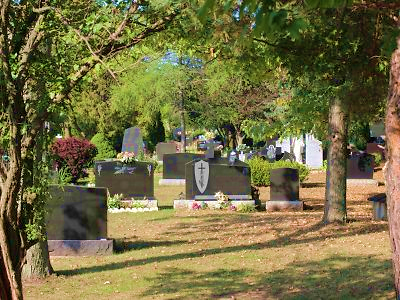Is Cremation Permitted In The Ukrainian Orthodox Church?
Written by Fr. Dr. J. BucioraIntroduction
This question is very critical especially in our Western world, where there is a strong influence upon our society by the eastern religions and a sentimental/romantic view regarding death and human remains. We also have to accept the fact that this is a very sensitive question for many of our parishioners, which needs to be dealt in a broader context of our life. In many cases, our parish members have to deal with the last wishes of a deceased member of their family, who have adamantly chosen to be cremated. In addition, our parish members are facing an accelerated push for the acceptance of cremation from contemporary society, where cremation has been accepted as a viable option.
A Shortened Analysis
For our purpose, I will shorten the analysis to the fundamental principles of the doctrine of the Church. As we research the collected material related to cremation from the Orthodox perspective, we will notice that the discussion on cremation is embraced by a variety of short articles often reiterating the same existing foundations or paraphrasing each other. This also includes official statements of the Local Orthodox Churches, which treat the subject as a condensed form focusing more on directives for the faithful and clergy.
Five Reasons
At the very beginning, we have to underline the fact that there is, in all of the existing sources of the Orthodox Church, a very negative approach to the subject to cremation. There are five reasons why the Orthodox Church is against cremation. In the perspective of the Church, the first reason, cremation was considered as a pagan custom, which was rejected by the Orthodox faithful. The second reason - cremation goes against the teaching of the Resurrection, the last Great Judgement and the raising of the dead [and the need for our physical bodies]. For this specific reason as the third reason, St. Basil the Great in his 91st canon affirms the preservation of the unwritten tradition, including the prohibition of cremation, which carries the beliefs and customs of the Church. The fourth reason is associated with the burial of Jesus Christ as represented in the Holy Gospels. The burial of the Son of God is the primary source for our burial. The fifth argument is based on the exegesis of our Bible: the Old and New Testaments where there is overwhelming evidence for the traditional burial practiced in the Orthodox Church.
Churches Built on Graves
The position taken by the early Church has been upheld by the Orthodox faithful from her very beginning. According to St. Paul in 1 Cor. 6:19-20, our body is the temple of the Holy Spirit which needs to be treated with honour and dignity. St. Paul emphasizes in his address to the Church of Corinth, widely known for sexual immorality, the dignity of the human body. As the temple of the Holy Spirit, the body is baptised by the Holy Orthodox Church and subsequently sealed during the sacrament of Chrismation with the seal of the Holy Spirit. The third Sacrament, which incorporates the individual into the Church - the Holy Eucharist completes the return of the body to its original destiny. A continual sanctification of the human body in the Sacraments of the Church is a process, which never ceases or changes its final destiny. Even at the time of the Christian persecutions (three centuries of our era), martyrdom of the many witnesses for Christian faith was always associated with burial of the remains. The emphasis of the martyrdom of the Saints and their burial places was so strong for the early Christian that the Church built the churches on the graves of the martyrs. The continuity of this belief expands to our time, where the Holy Liturgy in the Orthodox Church is celebrated on the Holy Antyminsion, which contain the relics of the saints. Without the Antyminsion on the altar, there is no celebration of the Eucharist in the Orthodox Church. As a result, although our body experiences the present realities, in the Holy Eucharist it transfigures and returns to the realm of paradise. This is one of the reasons why during the Church service, the priests censes not only the entire church with icons, but at the end the censor is directed towards the worshipers as potential holy icons. The body is in a process of continual sanctification and transfiguration in order to become what God has destined it to be.
A Temple of the Holy Spirit
The miracle of the smile of Blessed Elder Joseph of Vatopedi Monastery, Mt. Athos
The most important statement of St. Paul, was that our body is the body of the Holy Spirit. According to St. Paul, the human body as the temple of the Holy Spirit overcomes the context of time and death. There is nothing in the statement of St. Paul, which separates the Holy Spirit from the temple which is the body. The body is the place where the Holy Spirit dwells. Even at the point of death, the Spirit is present as there is no death in God. Even though the body disintegrates after death, the process of disintegration does not separate the Holy Spirit from the remains. We have to be mindful of the fact that after the Resurrection of Christ even the death of humanity could be understood as another form of life in God. The disintegration of the human body is a process, which underlines the continuation of life in a different form. Even though the body disintegrates into the elements of the earth, the body continues its presence of the living material world, although changed and unrecognizable. The place where the body is placed (grave) is the abode of honour and dignity, which is acknowledged by all majority of religions and faith traditions. For the Christian Orthodox Church, the foundation of the dignity and honour of a grave presupposes a continual presence of the Spirit of God, which is continually accentuated by our visitations, prayers, and blessings with holy water.
In the Ukrainian Tradition
The Ukrainian Orthodox Church views gravesites and cemeteries as special places of prayer and spiritual reflection. Our grave visitations on our love ones’ anniversary, after Easter for provody, Saturday before Pentecost and on Saturday before feast day of St. Demetrius are the sign of our remembrance and continual prayers for them.
The Grave as a Reminder
The burial of the human body in the grave is also a continuation of the Old Testament promise of God to the nation of Israel:
Therefore prophesy and say to them: ‘This is what the Sovereign LORD says: My people, I am going to open your graves and bring you up from them; I will bring you back to the land of Israel. (Ezekiel 37:12).
The presence of the faithful and members of the family by the grave exemplifies the presence of the Church in the world. The grave becomes a reminder of the return to paradise.
A Cosmic Dimension
The traditional burial of the deceased members of the Church has also another cosmic dimension, which needs to be taken into consideration. The remains of the deceased in the grave becomes a vehicle of the transformation of the surrounding world. The grave becomes a venue through which the Holy Spirit continually transforms the world. A priest blesses the grave with Holy water, which in fact is a continuation of the sacramental blessing after the feast of Jordan. As a result, the human body becomes a transformative tool of the Holy Spirit.
Understanding Cremation
The introduction of cremation into the life of our society abolishes in principle the entire doctrinal foundation for the traditional burial of the human body. In effect, cremation introduces a barrier in the religious life of the Church, where the remains cease to be a vehicle of the continual transformation by the Holy Spirit. Cremation removes the human body from the process of sanctification as it is isolated from the universal process of returning back to its origin. The words from the Funeral Service of the Orthodox Church are at this point the most expressive: “Earth, dust and ashes are you, O man, and unto the earth shall you return, according to the ordinance of God”. The incineration of the human body is a form of mutilation of the dignity and honour bestowed by God as a temple of the Holy Spirit. It is a selfish act, which is not blessed by the Church. As a result, we are removing ourselves and isolating our remains from the process, which presupposes a synergy between human and God. In cremation we interfere in the Divine plan for wider restoration of the world, which is not accepted by the Orthodox Church in its practice.
In fact, cremation is a violent destruction of our existence, which had been sanctified in the Church through its entire life. As a point of interest for all of us: the remains or so called ashes received by the families in the urn are no ashes, but incinerated bones of a human skeleton which remain after the process of cremation. The urn contains only powdered calcium, as there is nothing left after burning in (between 760-1150 Deg. C) an incinerator for two hours. If this is a dignified way of burying our beloved ones then there is nothing else to add.
Always in our Prayers
In light of the presented and very limited material, the Orthodox Church is consistent with the past and does not accept cremation as a substitution for a traditional burial. As a result, the Orthodox Church refuses to participate in cremation and does not bury the remains. However, from the pastoral perspective, the Orthodox Church will always pray for the soul of the cremated person even though the body has been destroyed through the violent process of cremation.



